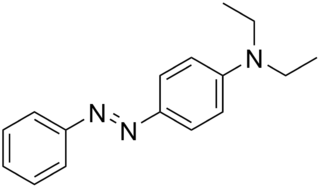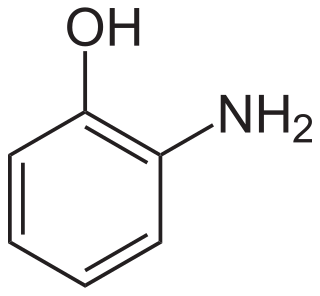
Congo red is an organic compound, the sodium salt of 3,3′-([1,1′-biphenyl]-4,4′-diyl)bis(4-aminonaphthalene-1-sulfonic acid). It is an azo dye. Congo red is water-soluble, yielding a red colloidal solution; its solubility is greater in organic solvents. However, the use of Congo red has long been abandoned, primarily because of its carcinogenic properties.

Azo compounds are compounds bearing the functional group diazenyl R−N=N−R′, in which R and R′ can be either aryl or alkyl.

Acid dyes are anionic, soluble in water and are essentially applied from acidic bath. These dyes possess acidic groups, such as SO3H and COOH and are applied on wool, silk and nylon when ionic bond is established between protonated –NH2 group of fibre and acid group of dye. Overall wash fastness is poor although lightfastness is quite good. As dye and fibre contain opposite electrical nature, strike rate and uptake of acid dye on these fibres is faster; electrolyte at higher concentration is added to retard dye uptake and to form levelled shades. Acid generates cation on fibre and temperature helps to substitute negative part of acid with anionic dye molecules.

Mordant red 19 is an organic compound with the chemical formula C16H13ClN4O5S. It is classified as an azo dye.
An azo coupling is an organic reaction between a diazonium compound and another aromatic compound that produces an azo compound. In this electrophilic aromatic substitution reaction, the aryldiazonium cation is the electrophile and the activated arene is a nucleophile. In most cases, including the examples below, the diazonium compound is also aromatic.
A substantive dye or direct dye is a dye that adheres to its substrate, typically a textile, by non-ionic forces.
Solvent Black 3 is an azo dye. It is nonfluorescent, relatively thermostable lysochrome diazo dye used for staining of neutral triglycerides and lipids on frozen sections and some lipoproteins on paraffin sections. It has the appearance of a dark brown to black powder with maximum absorption at 596–605 nm and melting point 120–124 °C. It stains blue-black.

Sudan Yellow 3G, also known as Solvent Yellow 16, C.I. disperse yellow and C.I. 12700, is a yellow azo dye. It is soluble in fats and oils.

Solvent Yellow 56 is the organic compound N,N-diethyl-p-(phenylazo)aniline. It is an azo dye, which has the appearance of a reddish yellow powder. Its EINECS number is 219-616-8. Its structure is similar to Solvent Yellow 124, which used as a fuel dye in European Union, and to Aniline Yellow.

Sulfanilic acid (4-aminobenzenesulfonic acid) is an organic compound with the formula H3NC6H4SO3. It is an off-white solid. It is a zwitterion, which explains its high melting point. It is a common building block in organic chemistry.

2-Aminophenol is an organic compound with the formula C6H7NO. Along with its isomer 4-aminophenol, it is an amphoteric molecule and a reducing agent. It is a useful reagent for the synthesis of dyes and heterocyclic compounds. Reflecting its slight hydrophilic character, white powder is moderately soluble in alcohols and can be recrystallized from hot water.

Acid Orange 7, also known as 2-naphthol orange is an azo dye. It is used for dyeing wool. It is produced by azo coupling of β-naphthol and diazonium derivative of sulfanilic acid.

Direct Blue 1 is an organic compound that is one of many azo dyes. This salt is used as a substantive dye for textiles with high contents of cellulose, i.e. cotton. It is prepared by the azo coupling of the aminonaphthalene and diazotized derivative of o-dianisidine.

Acid red 88 is an azo dye. Due to its intense colour, solid samples appear almost black. It is used to dye cotton textiles red. A closely related acid dye is Acid Red 13.

Acid Red 13 is an azo dye. It is produced as a sodium salt. Solid samples appear dark red.

N-Ethyl-N-(2-chloroethyl)aniline is the organic compound with the formula C6H5N(Et)(CH2CH2Cl) (Et = ethyl). It is a low-melting colorless solid that is an alkylating agent. The compound is a precursor to several cationic azo dyes via reaction of the chloroethyl group with tertiary amines or pyridine followed by azo coupling. Examples of derived dyes include C. I. Basic Red 18, Maxilon Red 2GL, and Yoracryl Red 2G.

Metal-complex dyes are a family of dyes that contain metals coordinated to the organic portion. Many azo dyes, especially those derived form naphthols, form metal complexes by complexation of one of the azo nitrogen centers. The insertion of the metal into the organic ligand often involves redox reactions, e.g. pre-reaction of sodium dichromate with glucose. Phthalocyanine (Pc) complexes, such as CuPc, are another important family of metal complex dyes.
Basic Red 18 is a cationic azo dye used for coloring textiles. The chromophore is the cation, which contains many functional groups, but most prominently the quaternary ammonium center.

o-Dianisidine is an organic compound with the formula [(CH3O)(H2N)C6H3]2. A colorless or white solid, it is a bifunctional compound derived via the benzidine rearrangement from o-anisidine.

Acid orange 19 is an azo dye that is used to color polyamide and wool fibers.
















